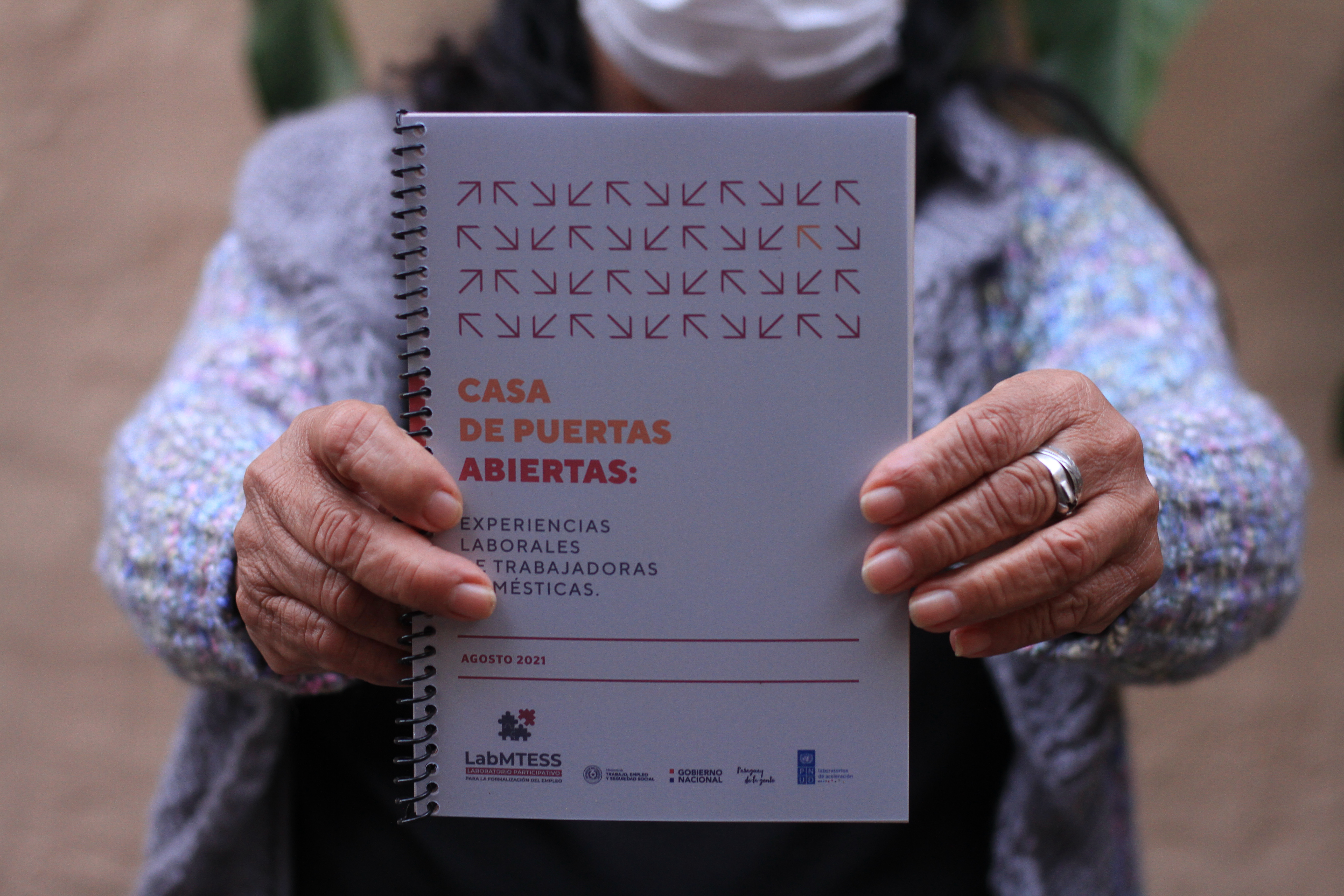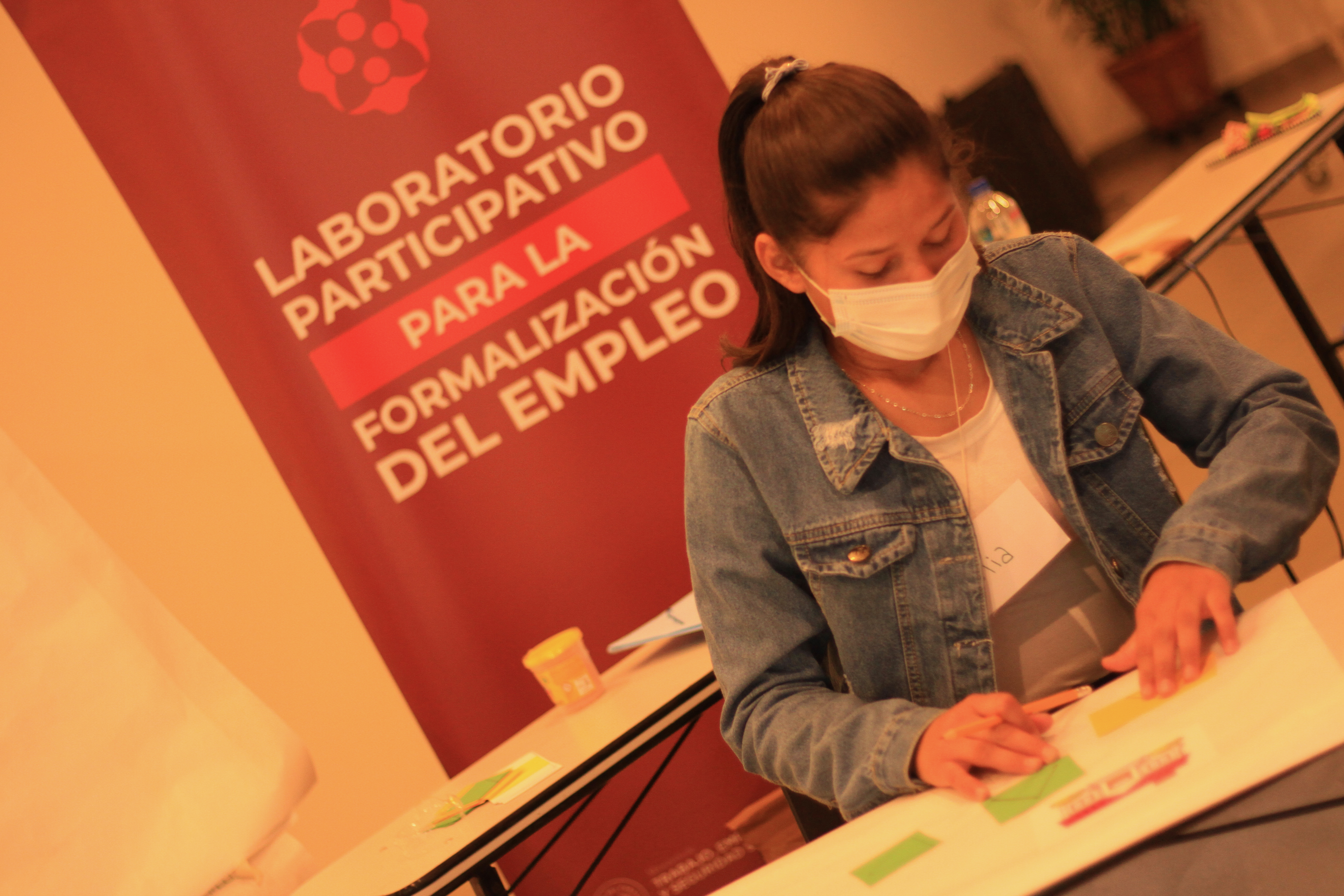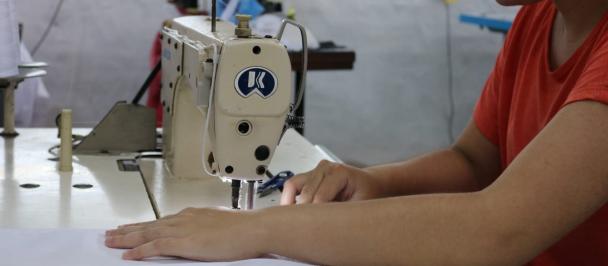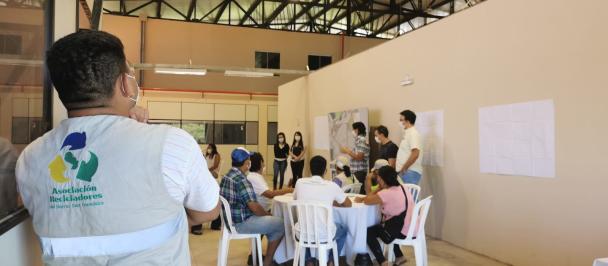Cultural probes: What are they and why are they useful?
In Their Own Voice: Understanding Domestic Work from the Perspective of Workers’ Experiences
25 de Agosto de 2022

workbook "Casa de Puertas Abierta: Experiencias laborales de trabajadoras domésticas" (Open Doors House: Labor experiences of domestic workers). Cultural Probe.
In the last post in this series, we reported findings from the project’s exploration phase. These touched on the barriers to formalizing domestic work faced by employers in the sector. In this blog we want to share our findings from the vantage point of domestic workers.
Our exploratory work with domestic workers sought to answer the following research question, which we developed based on what we had already learned about barriers to formalization in the sector: What kind of interventions are needed to transform the social and cultural practices that assign low social status to domestic work?
Based on this question, we also ask: what are the most persistent cultural practices associated with domestic works’ low social status and how can they be transformed? Regarding formalization of employment specifically, we ask: what are the subjective and objective factors that shape actors’ awareness and opinion of social security affect enrollment in IPS? We tackled these questions through an exploration of the labor trajectories of domestic workers and by mapping of the support networks that aid their entrance into the labor market. This was carried out via face-to-face workshops and cultural probes.

Participant completing her labor trajectory during the exploration workshop with domestic workers.
Cultural probes: What are they and why are they useful?
To deepen our understanding of the sector from the vantage point of domestic workers, we employed a cultural probe. This is a research method used gather information about a group through self-reporting. In this methodology, interacting with people is critical .
We chose this methodology because it allows us to capture people's perceptions and daily experiences through constant interaction and contact, generating an effective research dynamic. Moreover, the methodology is especially apt for working with a group whose work is carried out in isolation in spaces that allow for little to no socialization among peers.
We communicated with research participants over the course of two weeks via text messages, audio messages, and photographs shared on WhatsApp. This allowed us to carry out the research using an everyday tool. The cultural probe’s script walks participants through a symbolic representation of a house to promote and guide the interaction. In this schema, the door represents workers’ entrance into the world of work; the hallways represent the various jobs and types of work carried out as part of a career in domestic labor, which we explored via reflective exercises; the pillars represent the people and institutions that comprise workers’ support network; the ceiling represents workers’ assessment of health and retirement services; and, finally, the windows represent a space for workers to envision their retirement years.
Twenty-two unionized and non-unionized domestic workers participated in the probe. They were between 20 and 60 years old, and the group had an average age of 28. Most of the participants were single mothers, with an average of three children, who work informally.

Some parts of the house were used as symbolic elements to discuss about paid domestic work.
Main Findings of the Cultural Probe. "Open House: A View into Domestic Workers’ Work Experiences"
- The Door: most of the participating workers entered the labor force at a young age, sometimes before reaching adolescence. This is related to the cultural practice of criadazgo. In the probe a worker said, "I started at 12 years old. I would go to school and then I got the job through a classmate." Entry into the labor force is mediated by people close to workers’ families, and in all the cases observed it was under conditions of precarity.
- The Hallway: This part of the probe revealed that most of the participants have had a working relationship of between 3 to 20 years with a single family. During this time, they helped rear the family’s children, a task which creates a delicate balance between affective and labor relations.
With regard to participants’ work trajectories, we made a noteworthy observation. As a result of the pandemic, there was a shift in workers’ contract type. Some workers who had previously worked fulltime and enjoyed access to IPS were re-hired as part time workers. This shift triggered a search for side work and brought workers into a new work paradigm: jobbing or gig work.
- The Pillars: This part of the probe shed light on the kinds of support networks domestic workers rely on to enter and remain in the labor market. Most workers leave their children in the care of relatives, mainly their mothers and sisters. Thus, we observe a family care network that allows some women to leave the home to do paid work while others stay at home to do their own family’s care work.
- The Roof: Among participants with access to IPS, we found a positive assessment of the institution. Moreover, participants who do not have IPS mentioned a recurrent use of public health services. There is a notably positive assessment of having IPS during pregnancy: participants mentioned the quality treatment and care services provided for pregnant women. They especially valued the maternity leave benefit.
- The Window: The probe showed participating workers’ desire for a dignified retirement. They recognize that, due to limited access to IPS and to the terms of the recently approved Domestic Work Law (Ley de trabajo doméstico, 2015), a majority of workers will not obtain this benefit in the short term. However, a union leader recognized the meaning of this achievement, saying, "We are working to ensure that those who come after us have these rights." Participants identified the changes in work contracts from full-time to part-time as part of a prolonged obstacle course along the way to obtaining the right to retirement.
“You live day to day, you earn little, and it is only to support yourself and your children. The truth is that I see little chance of getting to retire,” says a participant.
- Words in images: During the second week of the probe, participants shared their notions of trust, good employers, and what makes them feel valued or discriminated against via photographs. The main barrier identified is the low status of domestic work, which is reflected in small things like requiring permits to miss work when a workers’ child is ill. The participants highlighted “trust” as a way to improve their relationship with their employer.
Participants identify substantive legislative progress, as there is now national legislation on domestic work and wage equalization, a way to resolve institutionalized discrimination. But barriers persist that limit the fulfillment of their rights. Many of them are the legacy of social and cultural norms around domestic work.
The cultural probe allowed us to better understand the barriers to formalization in the sector by drawing on the experience of domestic workers. We also put their perspectives in dialogue with observations generated from the perspective of employers.
The general findings of this cultural probe allow us to highlight the chokepoints that limit the entry of domestic workers into the labor market. It is necessary to have a care policies and to support the professionalization of the sector, including soft skills, in order to strengthen workers’ negotiation skills. It is equally important to focus on the cultural practice of criadazgo as the standard entryway into the world of domestic work.
The mixed assessment of IPS services demonstrates the need to carry out an awareness-raising campaign about social security and pension coverage in order to strengthen domestic workers self-identification as workers with rights to health services and a dignified retirement. Auditing compliance with current legislation continues to be a key challenge in a sector where work is carried out behind closed doors.
Finally, we now turn to the experiment phase of our project, and will focus on the design and implementation of a prototype service that addresses the barriers identified in our work with employers. We will present this prototype in the next blog. However, the findings of the cultural probe contribute to our understanding of a number of cultural and contextual barriers that we hope will inform future experiments.
Para leer este blog en español, click aquí.

 Locations
Locations



